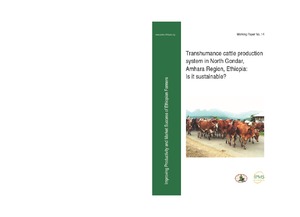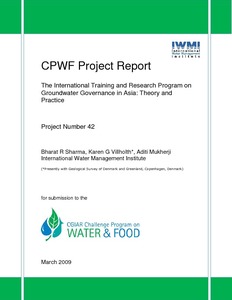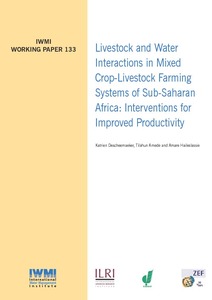CGIAR is the only worldwide partnership addressing agricultural research for development, whose work contributes to the global effort to tackle poverty, hunger and major nutrition imbalances, and environmental degradation.
It is carried out by 15 Centers, that are members of the CGIAR Consortium, in close collaboration with hundreds of partners, including national and regional research institutes, civil society organizations, academia, development organizations and the private sector.
The 15 Research Centers generate and disseminate knowledge, technologies, and policies for agricultural development through the CGIAR Research Programs. The CGIAR Fund provides reliable and predictable multi-year funding to enable research planning over the long term, resource allocation based on agreed priorities, and the timely and predictable disbursement of funds. The multi-donor trust fund finances research carried out by the Centers through the CGIAR Research Programs.
We have almost 10,000 scientists and staff in 96 countries, unparalleled research infrastructure and dynamic networks across the globe. Our collections of genetic resources are the most comprehensive in the world.
What we do
We collaborate with research and development partners to solve development problems. To fulfill our mission we:
- Identify significant global development problems that science can help solve
- Collect and organize knowledge related to these development problems
- Develop research programs to fill the knowledge gaps to solve these development problems
- Catalyze and lead putting research into practice, and policies and institutions into place, to solve these development problems
- Lead monitoring and evaluation, share the lessons we learn and best practices we discover;
- Conserve, evaluate and share genetic diversity
- Strengthen skills and knowledge in agricultural research for development around the world
Making a difference
We act in the interests of the world’s poorest and most vulnerable. Our track record spans four decades of research.
Our research accounted for US$673 million or just over 10 percent of the US$5.1 billion spent on agricultural research for development in 2010. The economic benefits run to billions of dollars. In Asia, the overall benefits of CGIAR research are estimated at US$10.8 billion a year for rice, US$2.5 billion for wheat and US$0.8 billion for maize.
It has often been cited that one dollar invested in CGIAR research results in about nine dollars in increased productivity in developing countries.
Sweeping reforms for the 21st century
Political, financial, technological and environmental changes reverberating around the globe mean that there are many opportunities to rejuvenate the shaky global food system. Developments in agricultural and environmental science, progress in government policies, and advances in our understanding of gender dynamics and nutrition open new avenues for producing more food and for making entrenched hunger and poverty history.
The sweeping reforms that brought in the CGIAR Consortium in 2010 mean we are primed to take advantage of these opportunities. We are eagerly tackling the ever more complex challenges in agricultural development. We are convinced that the science we do can make even more of a difference. To fulfill our goals we aim to secure US$1 billion in annual investments to fund the current CGIAR Research Programs.
CGIAR has embraced a new approach that brings together its strengths around the world and spurs new thinking about agricultural research for development, including innovative ways to pursue scientific work and the funding it requires. CGIAR is bringing donors together for better results and enabling scientists to focus more on the research through which they develop and deliver big ideas for big impact. As a result, CGIAR is more efficient and effective, and better positioned than ever before to meet the development challenges of the 21st century.
We are no longer the ‘Consultative Group on International Agricultural Research’. In 2008 we underwent a major transformation, to reflect this and yet retain our roots we are now known simply as CGIAR.
Members:
Resources
Displaying 9521 - 9525 of 12598Transhumance cattle production system in North Gondar, Amhara region, Ethiopia: is it sustainable?
The study was carried out in three highland woredas (districts) of Chilga, Dembia and Gondar Zuria in north Gondar Zone, Amhara Region, Ethiopia. These woredas were purposively selected because of their long experience in transhumance cattle production system. The objectives of the study were to characterize the transhumance cattle production system, identify the major constraints and forward appropriate developmental interventions for the future. Informal and formal surveys were employed to collect qualitative and quantitative data.
The international training and research program on groundwater governance in Asia: Theory and practice
CGIAR-CPWF Project “International Training and Research Program on
Groundwater Governance in Asia: Theory and Practice” was designed and
implemented by International Water Management Institute (IWMI) to address the
deficiencies in human capacity of managing groundwater in the two large basins of
the world- the Indus-Gangetic basin and the Yellow River basin. The basic premise of
the project was that proper groundwater management needs to be built on informed
knowledge of professionals from the region, with emphasis on inter-disciplinary
Water and poverty in two Colombian watersheds
Watersheds, especially in the developing world, are increasingly being managed for both environmental conservation and poverty alleviation. How complementary are these objectives? In the context of a watershed, the actual and potential linkages between land and water management and poverty are complex and likely to be very site specific and scale dependent. This study analyses the importance of watershed resources in the livelihoods of the poor in two watersheds in the Colombian Andes.
Livestock and water interactions in mixed crop-livestock farming systems of sub-Saharan Africa: interventions for improved productivity
In sub-Saharan Africa (SSA), the increasing competition for water between various sectors is aggravated by growing demands for water, climate change and environmental degradation. One of the major consumers of water is livestock keeping, which is an important livelihood strategy for smallholder farmers in Africa. The water consumption for livestock production is currently increasing with the growing demands for livestock products. On the other hand, current low returns from livestock, limit its contribution to livelihoods, threaten environmental health and aggravate local conflicts.
Small multi-purpose reservoir ensemble planning
People living in arid areas with highly variable rainfall, experience droughts and floods and often have insecure livelihoods. Small multi-purpose reservoirs are a widely used form of infrastructure for the provision of water. They supply water for domestic use, livestock watering, small scale irrigation, and other beneficial uses. The reservoirs are hydrologically linked by the streams that have been dammed.






